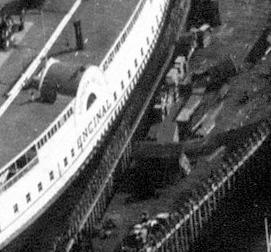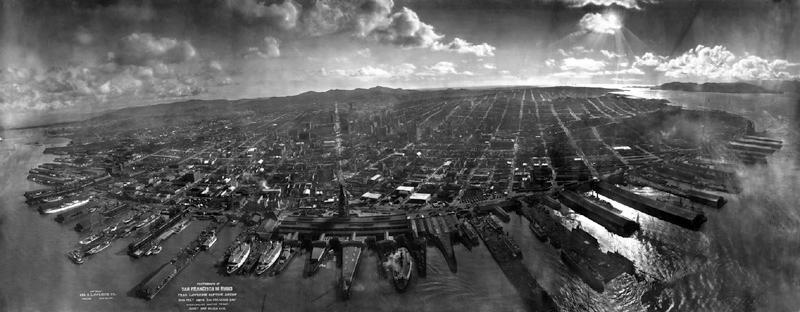George Lawrence home page
Most everybody who's seen that picture has seen it (printed or
downloaded) from one of the different resolution files from the Library
of Congress panoramic collection:
Several different resolution files available there,
from 37KB JPEG to 4MB TIFF.
However recently, perhaps in the last couple of years, the
Library
added a full scan of their original print, as a 160MB TIFF file. That's
a 40x increase in resolution. When printed out at 150 dpi, which is the
max. resolution of most ink jet printers, that 160MB file yields a
picture 6 ft. wide (since ink jet printers can't match the accuracy of
the original 4 ft. wide contact print). But being the L. of C., they
didn't take on a task to promote or advertise the new addition, not
their job really.

At that resolution you can read the names on the ferryboats,
and
count the windows in the Palace Hotel, and see the top story of the
Monadnock building (that survived 2 attempts by the Army to blow it up
as a firebreak, and is still standing on Market St. today). Plus
identify the ruins of Chinatown, where the Chinese landowners protested
a city plan to move them to Hunter's Point, at the far south limits of
the city, by refusing permission to clean the ruins on their property.
An entirely new picture from the previous L. of C. versions available.
There is another step I'd suggest, besides the simple 160MB
download, to see the picture as Lawrence saw it. You can bet he saw a
vivid black and white picture that sparkled, with strong contrast (any
photo taken directly into the setting sun would have strong contrast).
However what we see today is typically dull and washed out and often
brown with age, typical of an old photo.
Seems that historical librarians prefer dull and washed out
and
brown, that shows they have an original artifact. But anybody who's not
a historical librarian would probably like to see the picture about as
Lawrence saw it, vivid, alive, sparkling. There are two simple
steps to
restore a close version of the original picture from
the TIFF file,
after cropping that file to remove the scanner background:
- click to make it greyscale
- click to restore contrast range (Image > Auto
Levels, in Photoshop)
Of course, professional photo restorers probably have more
tricks, and
can get somewhat better or more accurate results. But to me seems to
promote Lawrence and his work it's good to publish a procedure that
anyone can do, do it yourself if you want.
(Webmaster's Note: I have
downloaded
the TIFF for you and converted it to a
20 megabyte JPEG, 11709 x 44716 pixels.)
What might be the biggest problem with showing people
Lawrence's
work is the
size
of the picture. You need at least an original 4 ft. wide
contact print, and if at 150 dpi (typical inkjet or magazine print
resolution) you need 6 ft. wide.
I've made several 6 ft. wide copies of
the picture, same resolution all over as in the ferry boat
detail. It is made of 28 sections, cut and taped
together to match.
But I think I do a good job (have made 3 copies so far), since even
advanced photographers have assumed it was one sheet of paper, when
they looked at it.
Worth the work to make a copy just to watch the
looks on people's
faces when they see it. I have to be careful when I show it, because
just by itself it can disrupt an entire meeting agenda. Very few people
have seen a Lawrence panorama at full resolution, and even less
restored to the 1906 appearance.
Showing the 6 ft. picture on an easel at the start of a historical
walking tour in San Francisco, I quickly got an audience of over 50
people closely packed together on the sidewalk. One man said he saw the
crowd from his room in a hotel across the street, and he came down just
to see what was happening. That's the power of a full resolution copy
of a Lawrence panorama.
Peter Nurkse
April 2006


